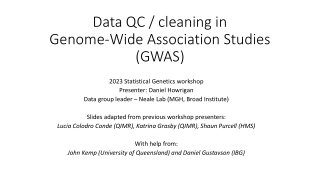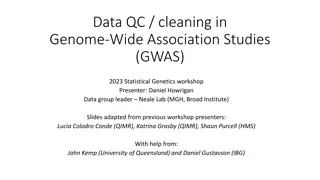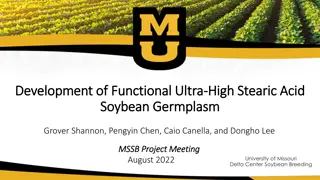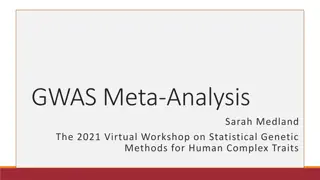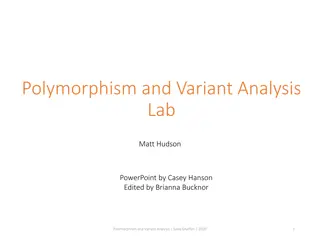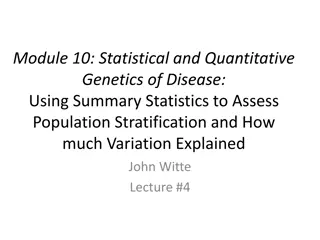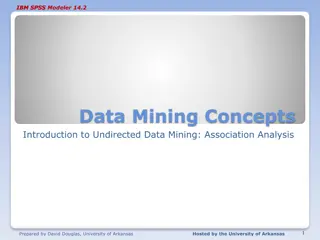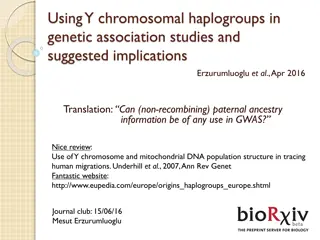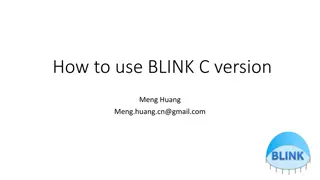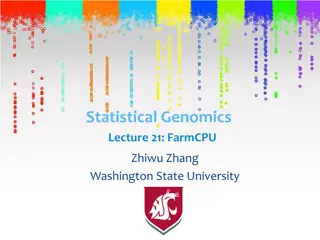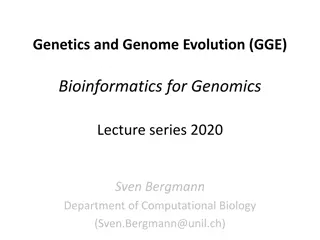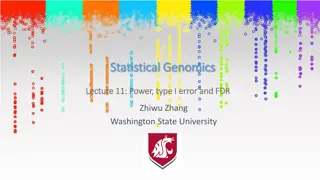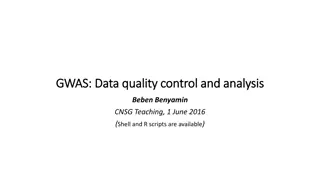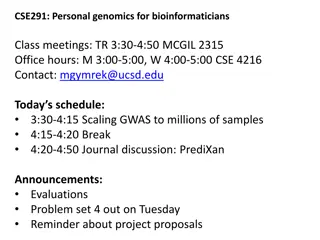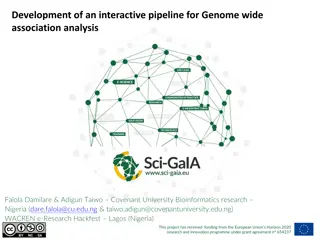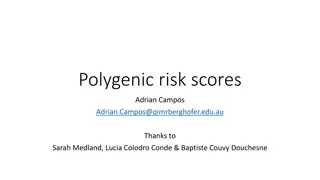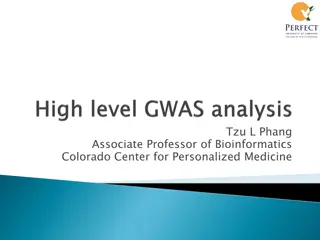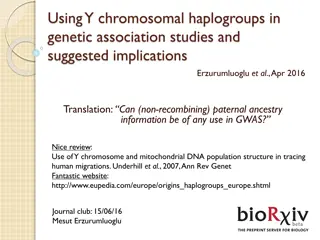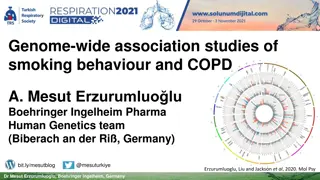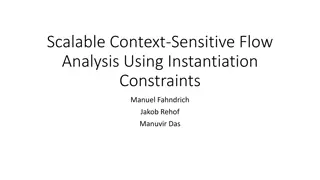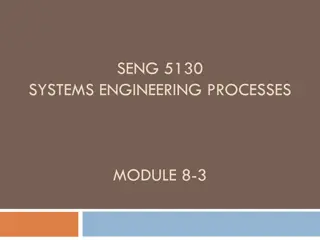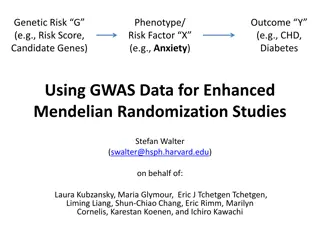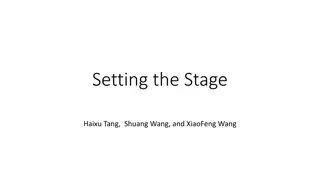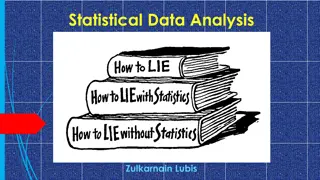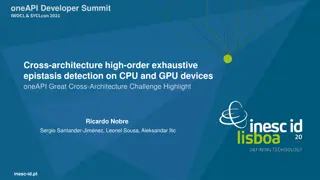Data QC / cleaning in Genome-Wide Association Studies (GWAS)
Daniel Howrigan, Data group leader at Neale Lab (MGH, Broad Institute), for a workshop on data QC and cleaning in GWAS. Learn about goals of GWAS, genetic data visualization, QC methods, and more.
2 views • 35 slides
Algorithm Analysis
Algorithm analysis involves evaluating the efficiency of algorithms through measures such as time and memory complexity. This analysis helps in comparing different algorithms, understanding how time scales with input size, and predicting performance as input size approaches infinity. Scaling analysi
2 views • 30 slides
Market Analysis (Project Formulation)
This detailed guide covers essential aspects of market analysis and project formulation in entrepreneurship, including feasibility analysis, techno-economic analysis, market demand analysis, steps in market analysis, and factors to consider for market demand analysis. Explore how to assess market de
2 views • 30 slides
Genome-Wide Association Studies in Statistical Genetics Workshop
Explore the essentials of Genome-Wide Association Studies (GWAS) and genetic data quality control as presented by Daniel Howrigan in the 2023 workshop. Delve into the goals of GWAS, genetic data characteristics, SNP variations, and genotyping techniques. Gain insights into moving from trait heritabi
1 views • 35 slides
Bioinformatics for Genomics Lecture Series 2022 Overview
Delve into the Genetics and Genome Evolution (GGE) Bioinformatics for Genomics Lecture Series 2022 presented by Sven Bergmann. Explore topics like RNA-seq, differential expression analysis, clustering, gene expression data analysis, epigenetic data analysis, integrative analysis, CHIP-seq, HiC data,
1 views • 36 slides
Comprehensive Cost Management Training Objectives
This detailed training agenda outlines a comprehensive program focusing on cost management, including an overview of cost management importance, cost object definition, cost assignment, analysis, and reporting. It covers topics such as understanding cost models, cost allocations, various types of an
5 views • 41 slides
Innovative Development in High Stearic Acid Soybean Germplasm Breeding at University of Missouri Delta Center
Innovative research on developing high stearic acid soybean germplasm is being conducted at the University of Missouri Delta Center. Challenges in breeding high stearic soybeans, such as sodium azide-induced deletions and mutant alleles in SACPDs, are being addressed. Promising lines identified from
1 views • 9 slides
Meta-Analysis in GWAS: Methods and Applications
Meta-analysis in GWAS involves combining data across studies to estimate overall effects, explore cohort differences, improve power, and replicate findings. It includes joint vs. meta-analysis, methods, and types such as fixed effect and random effect meta-analyses.
0 views • 20 slides
Polymorphism and Variant Analysis Lab Exercise Overview
This document outlines a lab exercise on polymorphism and variant analysis, covering tasks such as running Quality Control analysis, Genome Wide Association Test (GWAS), and variant calling. Participants will gain familiarity with PLINK toolkit and explore genotype data of two ethnic groups. Instruc
0 views • 43 slides
Data Analysis and Passage Analysis Project Proposal
This project proposal by Anthony Yang focuses on developing a Java program for data analysis and passage analysis. The motivation behind the project is to gain more knowledge in computer science and statistics-related topics while utilizing technology to extract useful insights from data. The propos
4 views • 8 slides
Statistical and Quantitative Genetics of Disease: Understanding Population Stratification
This lecture explores the use of summary statistics to assess population stratification and the impact of LD on association studies in statistical and quantitative genetics. It delves into LD scores, genomic inflation, polygenic inheritance, and separating SNP heritability from population stratifica
2 views • 29 slides
Introduction to IBM SPSS Modeler: Association Analysis and Market Basket Analysis
Understanding Association Analysis in IBM SPSS Modeler 14.2, also known as Affinity Analysis or Market Basket Analysis. Learn about identifying patterns in data without specific targets, exploring data mining in an unsupervised manner. Discover the uses of Association Rules, including insights into
3 views • 18 slides
Star-AI for Genetic Data Analysis: Incorporating Knowledge in Statistical Modeling
Knowledge-based approaches are crucial in genetic data analysis to enhance the accuracy and scope of genome-wide association studies (GWAS). Stochastic Relational AI (Star-AI) offers a solution by leveraging probability theory and First Order Logic to capture complex genetic interactions. By integra
0 views • 10 slides
Genomic Imputation Pipeline Overview
This document outlines a genomic imputation pipeline for multiple GWAS studies using reference panels such as 1000 Genomes Phase I data. It covers steps like data matching, phasing, and imputation using tools like Beagle and Minimac. The expected output includes imputed dosages and quality measures.
1 views • 6 slides
Introduction to Static Analysis in C.K. Chen's Presentation
Explore the fundamentals of static analysis in C.K. Chen's presentation, covering topics such as common tools in Linux, disassembly, reverse assembly, and tips for static analysis. Discover how static analysis can be used to analyze malware without execution and learn about the information that can
1 views • 54 slides
Y Chromosomal Haplogroups in Genetic Studies
Exploring the utility of non-recombining paternal ancestry information in Genome-Wide Association Studies (GWAS) through the analysis of Y chromosomal haplogroups. This review delves into the implications of using Y chromosome and mitochondrial DNA data in tracing human migrations, ancestry, bottlen
1 views • 27 slides
Industrial, Microbiological & Biochemical Analysis - Course Overview by Dr. Anant B. Kanagare
Dr. Anant B. Kanagare, an Assistant Professor at Deogiri College, Aurangabad, presents a comprehensive course on Industrial, Microbiological, and Biochemical Analysis (Course Code ACH502). The course covers topics such as Industrial Analysis, Microbiological Analysis, and Biochemical Analysis. Dr. K
3 views • 16 slides
Guide on Using BLINK C Version for Genetic Analysis
This guide provides step-by-step instructions on how to effectively use the BLINK C version for genetic analysis. It covers tasks such as preparing input files, handling phenotype and covariates data, implementing GWAS using BLINK, transforming genotype data, compressing to BLINK binary format, conv
1 views • 9 slides
Advancements in Statistical Genomics: FarmCPU and Method Development
Exploring the evolution of statistical genomics techniques, this lecture delves into the history of FarmCPU and BLINK, addressing challenges in GWAS and the development of models like PC+SNP+e and PC+Kinship+e. It also covers popular software packages in the field and the importance of moving beyond
0 views • 24 slides
Genomics and Bioinformatics in Genetics Evolution
Delve into the world of genomics and bioinformatics through the Genetics and Genome Evolution (GGE) lecture series by Sven Bergmann. Explore topics such as RNA-seq analysis, differential expression, gene expression measurement techniques, and integrative analysis with epigenetic data. Gain insights
2 views • 37 slides
Benefits of Probabilistic Static Analysis for Improving Program Analysis
Probabilistic static analysis offers a novel approach to enhancing the accuracy and usefulness of program analysis results. By introducing probabilistic treatment in static analysis, uncertainties and imprecisions can be addressed, leading to more interpretable and actionable outcomes. This methodol
0 views • 11 slides
Power, Type I Error, and FDR in Statistical Genomics
Explore concepts of statistical genomics in Lecture 11 focusing on power, type I error, and false discovery rate (FDR) in GWAS analysis. The content covers simulations of phenotype from genotype data, GWAS by correlation, resolution and bin approach, and implications on QTN bins for power and error
0 views • 21 slides
GWAS: A Brief Overview of Genetic Association Studies
GWAS, or Genome-Wide Association Studies, are a method used to map genes associated with traits or diseases by analyzing genetic markers throughout the genome. This process involves statistically testing the association between SNPs and traits using regression or chi-squared tests in a hypothesis-fr
1 views • 19 slides
Challenges and Solutions in Scaling GWAS for Bioinformaticians
Exploring the challenges of scaling Genome Wide Association Studies (GWAS) to millions of samples, covering topics like FastPCA, TeraStructure, and imputation with Eagle. The session delves into working with summary statistics, exemplified by PrediXan journal discussion, and outlines concepts and ex
0 views • 46 slides
Development of an interactive pipeline for Genome wide
This project focuses on developing an e-infrastructure for accurate Genome Wide Association Study (GWAS) analysis, enabling researchers to efficiently study genetic variations and their associations with diseases. By providing a user-friendly interface and powerful visualization tools, this tool aim
0 views • 14 slides
Polygenic risk scores
Polygenic risk scores (PRS) utilize multiple genetic variants to estimate overall trait scores, improving prediction accuracy for complex traits. This presentation discusses GWAS, allele effect sizes, variant selection, LD considerations, and diverse PRS applications.
0 views • 40 slides
Genome-Wide Association Studies: Uncovering Disease Genetics
A genome-wide association study (GWAS) is an approach involving scanning markers across the genome to identify variations associated with a specific disease. Large subject numbers are required due to the low odds ratios expected between SNPs and causal variants. Such studies are valuable for discove
0 views • 15 slides
Genetic Associations Using Y-Chromosomal Haplogroups
Using Y-chromosomal haplogroups in genetic association studies can provide insights into ancestral origins, migrations, and disease susceptibility. This approach involves stratifying individuals based on their Y-DNA haplogroups to assess differential phenotypic effects. Explore the implications and
0 views • 27 slides
Factor Analysis
Factor analysis is a statistical method used to identify underlying factors that explain correlations among variables. It helps in reducing large datasets by finding uncorrelated variables. There are two types of factor analysis: Exploratory Factor Analysis (EFA) and Confirmatory Factor Analysis (CF
2 views • 18 slides
Genome-wide association studies of smoking behaviour and COPD
Genome-wide association studies explore the relationship between genetic variants and smoking behavior in COPD. Dr. Mesut Erzurumluoğlu and the Boehringer Ingelheim Pharma Human Genetics team in Germany discuss the genetic basis of smoking, single nucleotide polymorphisms (SNPs), alleles, and their
0 views • 12 slides
Challenges in GWAS: Data Quality Control and SNP QC
GWAS face challenges such as data quality control issues, small sample sizes, computational burden, and inadequate SNP coverage. SNP QC for GWAS involves identifying problems like Hardy-Weinberg equilibrium, missing genotypes, and frequency differences. Intensities must be converted to genotypes, an
1 views • 26 slides
Scalable Context-Sensitive Flow Analysis Using Instantiation Constraints
Context-sensitive flow analysis using instantiation constraints plays a crucial role in type inference for flow analysis. This approach involves constraint-based polymorphic type inference, construction of type instantiation graphs, and analysis of flows on these graphs. By extending to higher-order
0 views • 47 slides
Decision Analysis Tools and Models for Effective Decision-Making
The analysis of alternatives and decision-making processes in systems engineering is crucial for successful design and deployment. Various decision analysis tools, such as decision trees, decision matrix, cost/benefit analysis, force field analysis, grid analysis, and paired comparison analysis, hel
0 views • 38 slides
Genomic Data Privacy and Utility Analysis
Balance between privacy and utility in publicly released SNP data for GWAS, focusing on re-identification risks and identification of significant SNPs. The study involves datasets from the Personal Genome Project and HapMap Project, with emphasis on privacy protection techniques and association test
0 views • 22 slides
Understanding Meta-Analysis in GWAS: Methods and Applications
Explore the world of Meta-Analysis in Genome-Wide Association Studies (GWAS) through topics like combining data across studies, joint vs. meta-analysis, and types of meta-analysis. Dive deep into fixed and random effect models, how meta-analysis is used in GWAS, and its significance in estimating ov
0 views • 23 slides
Enhanced Mendelian Randomization Studies Using Genetic Risk Scores
Explore the application of genetic risk scores in enhanced Mendelian randomization studies to investigate the relationships between genetic risk, phenotypes such as anxiety and depression, and outcomes like CHD and diabetes using GWAS data. The study delves into projects focusing on anxiety, depress
0 views • 10 slides
Understanding Privacy and Utility Balance in Genomics Research
Explore the challenges and goals of balancing privacy and utility in genomic data sharing for GWAS. Analyze re-identification risks and significant SNP identification across case and control populations. Tasked with understanding the impact of proper anonymization on publicly released SNP data, this
0 views • 22 slides
Statistical Data Analysis Techniques and Types of Analysis Explained
Explore the world of statistical data analysis with a focus on choosing appropriate techniques, qualitative and quantitative analysis, types of qualitative analysis processes, and statistical analysis methods like explorative and confirmative data analysis. Understand the role of descriptive and ind
0 views • 30 slides
Multivariate GWAS in Genomic SEM: Steps and Example
Explore the process of Multivariate Genome-Wide Association Studies (GWAS) within Genomic Structural Equation Modeling (SEM). Learn the four primary steps involved, including munging summary statistics, running LD-Score Regression, preparing for multivariate GWAS, and conducting the analysis. Discov
1 views • 20 slides
Cross-Architecture High-Order Epistasis Detection on CPU and GPU Devices
Uncover the genetic basis of complex diseases through Genome-wide association studies (GWAS) and Single Nucleotide Polymorphism (SNP) analysis. Explore how epistasis helps explain certain traits and discover CUDA-based high-order epistasis detection methods. Learn about cutting-edge research in unde
0 views • 13 slides
